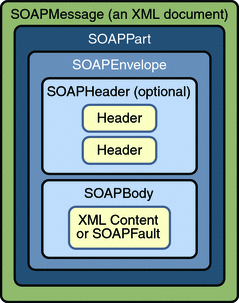Messages with No Attachments
The following outline shows the very high-level structure of a SOAP message with no attachments. Except for the SOAP header, all the parts listed are required to be in every SOAP message.
I. SOAP message
A. SOAP part
1. SOAP envelope
a. SOAP header (optional)
b. SOAP bodyThe SAAJ API provides the SOAPMessage class to represent a SOAP message, the SOAPPart class to represent the SOAP part, the SOAPEnvelope interface to represent the SOAP envelope, and so on. Figure 19–1 illustrates the structure of a SOAP message with no attachments.
Figure 19–1 SOAPMessage Object with No Attachments

Note –
Many SAAJ API interfaces extend DOM interfaces. In a SAAJ message, the SOAPPart class is also a DOM document. See SAAJ and DOM for details.
When you create a new SOAPMessage object, it will automatically have the parts that are required to be in a SOAP message. In other words, a new SOAPMessage object has a SOAPPart object that contains a SOAPEnvelope object. The SOAPEnvelope object in turn automatically contains an empty SOAPHeader object followed by an empty SOAPBody object. If you do not need the SOAPHeader object, which is optional, you can delete it. The rationale for having it automatically included is that more often than not you will need it, so it is more convenient to have it provided.
The SOAPHeader object can include one or more headers that contain metadata about the message (for example, information about the sending and receiving parties). The SOAPBody object, which always follows the SOAPHeader object if there is one, contains the message content. If there is a SOAPFault object (see Using SOAP Faults), it must be in the SOAPBody object.
- © 2010, Oracle Corporation and/or its affiliates
